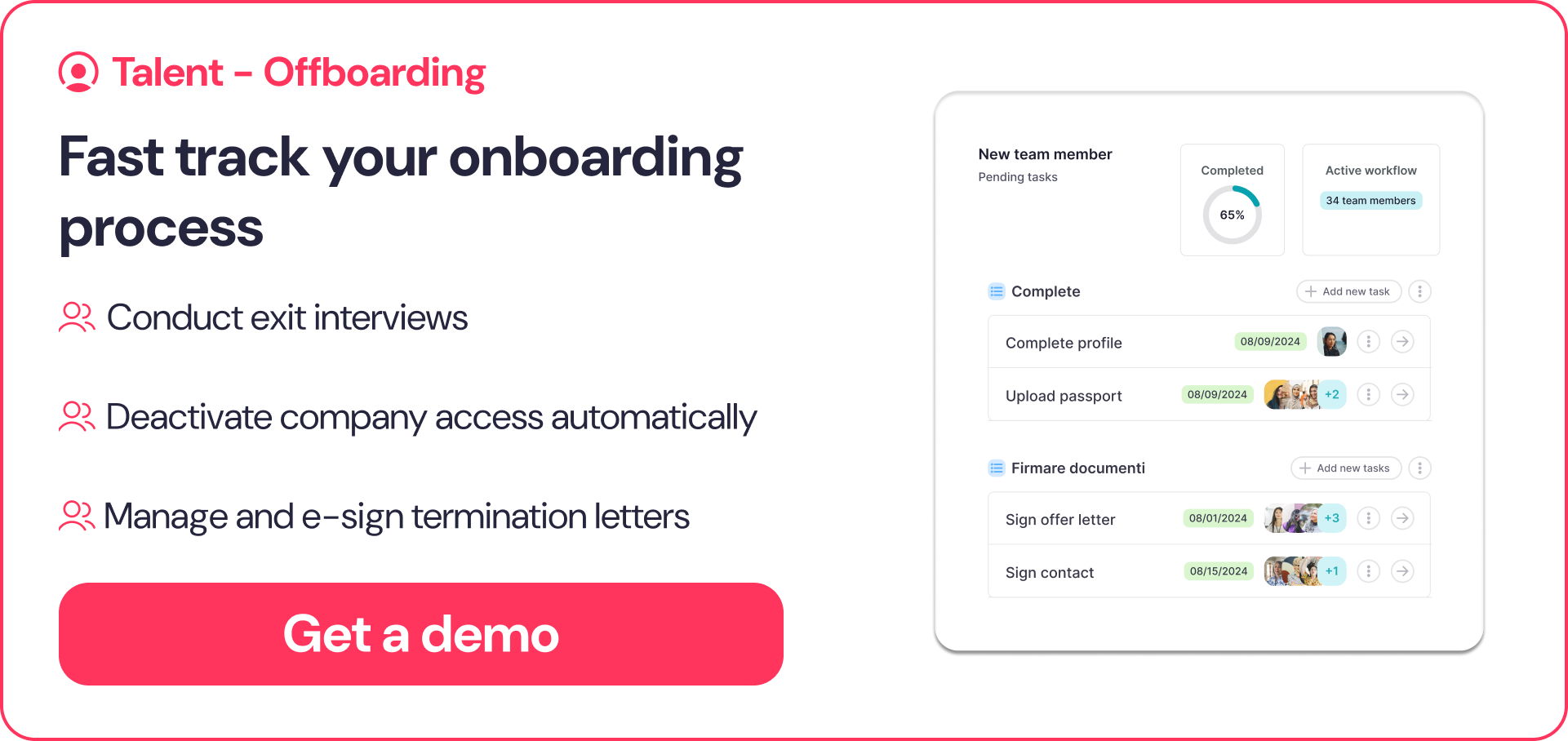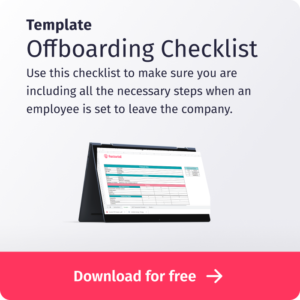HR managers need to understand the California WARN Act to protect employees during big workforce changes such as layoffs and plant closings. This quick guide covers what the Act is, who it applies to, notice rules, when it comes into play, and the penalties for not following it. It’s a straightforward overview to help HR professionals ensure they comply and safeguard employees during important work changes.
TABLE OF CONTENTS
- What is the California WARN Act
- California WARN Act Requirements
- CA WARN Covered Employers
- California State WARN Notice Requirements
- What Triggers California WARN Act
- When Does California WARN Act Apply
- California WARN Act exceptions
- Warn Act Penalty in CA
- Offboarding during layoffs
- Offboarding and document management software ✅
What is the California WARN Act
The California Worker Adjustment and Retraining Notification (WARN) Act protects employees during big changes in the workforce. While the federal WARN act provides a basic level of protection, some states, like California, New York, New Jersey, Wisconsin, and Illinois, have extra regulations in place. In California, the act applies to certain businesses, making sure that employees are given enough notice if the company shuts down, lays off many workers, or moves. Employers must follow both the federal WARN and the state WARN whenever a covered business goes through a significant change.
Related: California Employment and Labor Laws explained
California WARN Act Requirements
To trigger the California WARN Act, an employer must qualify as a “covered establishment“. Being a covered establishment means that you are employing or have employed 75 or more full and part-time employees in the previous 12 months. Employees must have a minimum of six months of employment within the 12-month period leading up to the required notice date.
CA WARN Covered Employers
Covered establishments include a diverse range of industrial or commercial facilities that meet the specified employment criteria. The Act’s application is broad and it encompasses various businesses with more than 75 employees within the last 12 months. The Act protects a wide array of workers, so it applies to many industries.
California State WARN Notice Requirements
Employers who are covered by the California WARN Act must provide a 60-day notice before there is a plant closure, layoff, or relocation. It isn’t enough to follow the list of requirements that are part of the federal WARN Act. In addition to federal WARN requirements, notifications must be sent to the Local Workforce Development Board. They must also be sent to the chief elected official of each relevant city and county in CA.
Also, apart from the federal requirements, the California WARN Act adds an extra step. Employers need to inform the Local Workforce Development Board and the top elected official in each city and county where the changes are happening. This extra layer of notification ensures that affected employees are well-informed but also that local authorities are aware of and ready for the potential impact on the community.
Following these rules is vital for employers to meet legal obligations and maintain positive relationships with employees and local communities during big changes.
Take control with intuitive Business Management Software.👇

What Triggers California WARN Act
The California WARN Act is triggered by specific events that impact the workforce. These triggers include a plant closure affecting any number of employees, a layoff involving 50 or more employees within a 30-day period, no matter how big a percentage of the workforce is affected, and a relocation of at least 100 miles that affects any number of employees. These events trigger the WARN Act, which ensures that employees receive advance notice and protection in the face of significant changes to their employment status.
The Act is triggered in the following scenarios:
1. Plant Closure: The California WARN Act applies when there is a plant closure affecting any number of employees.
2. Mass Layoff: A layoff of 50 or more employees within a 30-day period triggers the Act, regardless of the percentage of the workforce.
3. Relocation: The Act comes into play when there is a relocation of at least 100 miles that affects any number of employees.
When Does California WARN Act Apply
The California WARN Act outlines specific conditions under which it applies and provides exceptions to certain circumstances. The Act is applicable to a “covered establishment,” defined as an employer that has employed, in the preceding 12 months, 75 or more full and part-time employees. Similar to the federal WARN Act, employees must have a minimum of six months of employment within the 12 months preceding the required notice date to be counted.
The Act is triggered in the scenarios outlined above.
California WARN Act exceptions
The WARN Act doesn’t apply in California under the following exceptions:
- The completion of a project: If a closure or layoff happens because a specific project or task is finished, the Act doesn’t apply. This reason for this exception is for employers covered by certain Wage Orders and industries where employees were hired knowing their job was only for that project’s duration.
- Seasonal Employment: Employees that are hired for seasonal work don’t need the usual notice requirements. They are hired with the understanding that their job is temporary.
- Physical Calamity or Act of War: No notice is required if a mass layoff, relocation, or plant closure is caused by a physical disaster or war.
- Capital or Business Pursuit: In certain cases, if an employer actively seeks capital or business, and notifies the Department of Industrial Relations (DIR), they might not need to give notice before relocating or terminating employees. This is because giving notice could hinder their chances of securing the needed capital or business.
Employers need to understand these situations and exceptions in order to follow the California WARN Act properly and ensure they’re meeting requirements.
WARN Act Penalty California
Violating the California WARN Act can lead to serious consequences for employers. If they don’t follow the rules, they could be fined $500 per day for each day they are in violation of the law. It goes without saying that affected employees have rights too. They might get back pay, calculated based on their final salary or their average salary over three years—whichever is higher. Plus, employers may have to cover medical bills that would have been paid by the company’s health plan. This responsibility lasts for as long as the violation lasts. This can be up to 60 days or half the time the employee worked—whichever is shorter. These penalties show how important it is for employers to understand to the California WARN Act. Not doing so can lead to legal and financial problems for the company. It’s up to HR managers to make sure the company follows the rules, keeps all processes transparent, and avoids legal issues. Understanding all the details of the Act is key for HR professionals to handle workforce changes while respecting employees’ rights and needs.
California Work Sharing Program
California’s Work Sharing Program is a helpful option for employers dealing with a slowdown in production or services. The program gives them an alternative to laying off workers temporarily. It’s a way to keep trained employees on board across different industries. This way, when things pick up, the business can bounce back quickly. Employees who have their hours and pay reduced can still get unemployment benefits, keep their job, and handle financial difficulties better. This flexible plan is a win-win for both employers and workers during tough economic times.
California Laws
Looking for more information about California? Read up on California wages, State holidays, and more!
California articles:
- California Minimum Wage
- California State Holidays
- California Privacy Laws
- California Privacy Rights Act
- California Family Rights Act
- California Bereavement Leave
- California Pay Transparency Law
- California Overtime Laws
- California Paid Family Leave
Offboarding during layoffs
Understanding and complying with the WARN Act is crucial for HR managers, fostering fairness and transparency during workforce changes. By ensuring employee rights and maintaining open communication, HR professionals contribute to a positive workplace culture and compliance with regulations. After notifying employees of impending layoffs, the next crucial step is initiating the employee offboarding process.
Offboarding with Factorial:
Factorial simplifies the offboarding process, streamlining tasks and ensuring a smooth transition for departing employees. With Factorial, you can efficiently manage exit procedures, such as collecting company assets, updating access permissions, and conducting exit interviews. Offboarding software simplifies the entire process from start to finish.
Key Features for offboarding during layoffs:
1. Clear Communication: Easily communicate departure details to the departing employee, including the last day of work, return of company property, and other essential information.
2. Task Automation: Automate offboarding tasks, such as revoking system access, updating records, and notifying relevant departments, saving time and minimizing the risk of oversight.
3. Documentation and Compliance: Ensure compliance by generating necessary documentation, such as termination letters and exit surveys, helping you maintain a comprehensive record of the offboarding process.
4. Access Control: Centralize access control management, making it simple to revoke access to company systems and confidential information, safeguarding your organization’s data.
By utilizing Factorial for offboarding, HR managers can enhance efficiency, maintain compliance, and provide a positive experience for departing employees.




